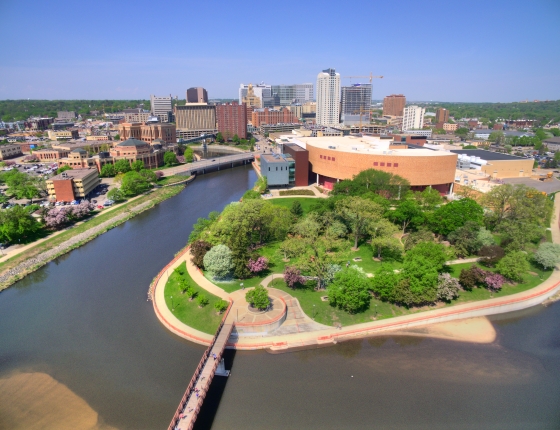“Reducing our greenhouse gas emissions isn’t something the City as a municipal entity can do alone; meeting our goals will require a community effort."
Lauren Jensen, sustainability coordinator, City of Rochester
From the City’s Energy Action Plan to the Energy Integration Committee’s Strategic Plan to participating in Climate Smart Municipalities, Rochester is working toward a more resilient, sustainable future.
As part of this innovative work, Center for Energy and Environment’s (CEE) Communities Department worked with the City of Rochester, Energy Commission, and Sustainability & Resiliency Task Force over the past two years to convene community stakeholders, create strategies, and measure impact toward their greenhouse gas reduction goals.
Creating a Work Plan
In 2020, CEE facilitated workshops with Rochester’s Sustainability & Resiliency Task Force, a 40-member team made up of a diverse cross-section of Rochester, to create a community work plan. This process intentionally represented all perspectives in Rochester, not only those most outspoken or influential. In addition to facilitated workshops, engagement included a community-wide survey and 37 community listening sessions that engaged more than 40 community groups. This engagement process was recognized by the Minnesota Climate Adaptation Partnership with their 2021 Partnership Award.
The result was the Sustainability & Resiliency Community Work Plan, which includes economic, environmental, and social resiliency recommendations that will guide the city’s future decisions. The work plan is centered on equity and includes six key areas: climate change resilience, vibrant neighborhoods, city of health, accessible transportation, resilient economy, and environmental health.
"The task force helped ensure that as a City we lead, support, and influence the strategies most important to our community and this recent analysis helped provide the data to back those strategies up.”
Lauren Jensen, sustainability coordinator, City of Rochester
Measuring Impact
CEE worked with the City to identify building and transportation strategies from Rochester’s Sustainability & Resiliency Community Work Plan that would have the greatest impact on reducing greenhouse gas emissions. Quantifying emissions reductions by strategy helps the City of Rochester prioritize future funding and staffing decisions to ensure they are on track to meet their carbon reduction goals.
The work by CEE’s team included an updated greenhouse gas emissions inventory and a new energy and travel emissions forecast that incorporates residential and business growth data from Rochester’s Comprehensive Plan 2040 and Rochester Public Utilities’ carbon-free fuel-mix goals. The team also modeled the greenhouse gas reduction potential of several building and transportation strategies, such as building and vehicle electrification, compact mixed-use development, on-site renewable energy, and energy efficiency.
The community work plan and greenhouse gas impact analysis help the City understand what it will take to reach their greenhouse gas reduction goal of reducing emissions 80% by 2050 and identifies opportunities to move the needle further for a more resilient, sustainable Rochester.
Related Links
Sustainability & Resiliency Community Work Plan (City of Rochester)
